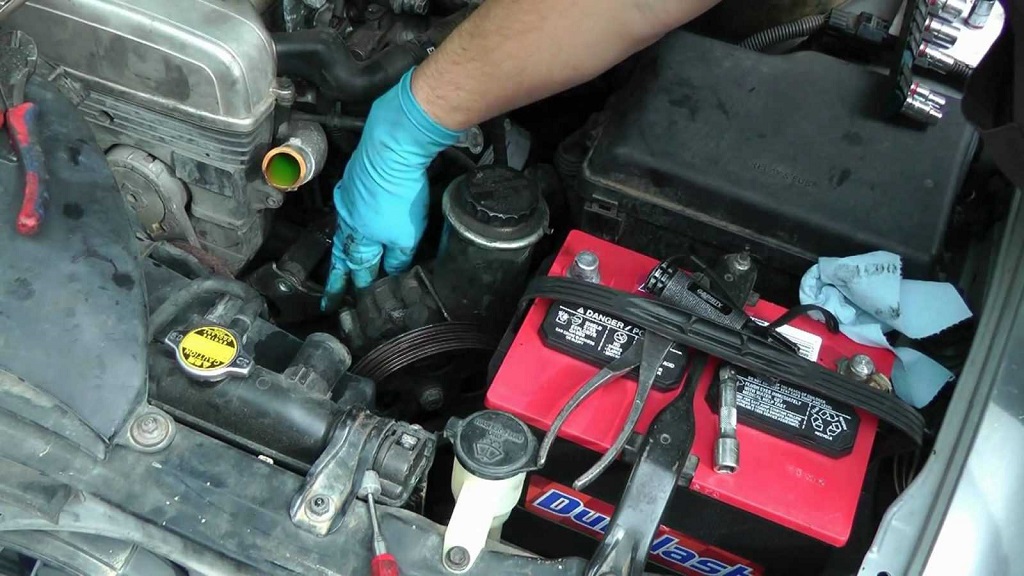A malfunctioning air conditioning system (AC) can turn even the most pleasant car ride into a sweltering ordeal. If your car’s AC struggles to keep you cool, the culprit might be a failing compressor. Replacing a car’s AC compressor can be a daunting task, but for the mechanically inclined DIYer with the right tools and knowledge, it’s an achievable project.
Before You Dive In: Signs of a Faulty AC Compressor
Before diving headfirst into replacing your compressor, it’s crucial to confirm that it’s indeed the source of the problem. Here are some telltale signs of a failing AC compressor:
- Lukewarm Air: This is the most common symptom. Even with the AC on full blast, the air coming out of the vents feels lukewarm or barely cool.
- Clutch Not Engaging: The compressor clutch engages and disengages to regulate pressure in the AC system. A faulty clutch might not engage at all, preventing the compressor from functioning.
- Unusual Noises: If you hear grinding, whining, or clunking sounds when the AC is turned on, it could indicate a failing compressor bearing or internal damage.
- Low Refrigerant Levels: While a leak in the system can cause low refrigerant levels, a failing compressor can also contribute to the problem.
Important Safety Precautions:
Replacing an AC compressor involves handling refrigerant, which can be harmful if not handled properly. Here are some safety precautions to prioritize:
- Wear Eye Protection: Refrigerant can cause eye irritation or even blindness if it comes into contact. Wear safety glasses or goggles throughout the process.
- Work in a Ventilated Area: Refrigerant has a strong odor and can be harmful if inhaled in concentrated amounts. Work in a well-ventilated area or wear a respirator.
- Dispose of Refrigerant Properly: Do not vent refrigerant into the atmosphere. Take the used refrigerant to a certified recycling facility.
- Use the Correct Tools and Procedures: This article provides a general overview, but consult your car’s service manual for specific instructions and torque specifications for your vehicle.
Disclaimer: Attempting AC repairs can be complex and requires proper knowledge and tools. If you’re uncomfortable with any step of the process, it’s best to consult a qualified mechanic.
Gathering the Necessary Tools and Parts:
Before starting the replacement process, ensure you have the necessary tools and parts:
- AC Compressor Recovery/Recycling Machine (can be rented): This specialized equipment is crucial for safely evacuating and recovering refrigerant from the AC system.
- AC Compressor (specific to your car model): Purchase a high-quality compressor compatible with your vehicle.
- New AC Compressor Oil: The type of oil will depend on the compressor model.
- Refrigerant Hoses (if needed): Some compressors might require replacing the refrigerant hoses as well.
- Standard Mechanic’s Toolset: This includes wrenches, sockets, screwdrivers, and pliers.
- Manifold Gauge Set (optional, but helpful): This can be used to monitor system pressure during the recharge process (professional recharge is recommended).
Steps to Replacing Your Car’s AC Compressor:
1. Evacuate the Refrigerant:
- Safety First! Ensure you’re working in a well-ventilated area and wearing proper eye protection.
- Consult your car’s service manual: The location of the refrigerant lines and service ports will vary depending on your car’s model.
- Connect the recovery/recycling machine: Follow the machine’s instructions to safely evacuate the refrigerant from the AC system. This process can take some time.
2. Remove the Old Compressor:
- Once the refrigerant is evacuated: Locate the AC compressor in your engine bay. It’s typically driven by a belt connected to the engine’s crankshaft.
- Disconnect the electrical connector: Identify the electrical connector that supplies power to the compressor and carefully unplug it.
- Disconnect the refrigerant lines: These lines connect the compressor to the rest of the AC system. Loosen the fittings carefully, remembering the order in which they were connected (refer to your manual if needed). Expect some residual refrigerant oil to leak out. Important: Cap the lines immediately to prevent dirt and moisture from entering the system.
3. Install the New Compressor:
- Prepare the new compressor: Inject the recommended amount of fresh AC compressor oil into the inlet port of the new compressor (refer to the compressor’s instructions).
- Install the new compressor: Carefully position the new compressor in place and secure it using the mounting bolts. Tighten the bolts to the torque
- Tighten the bolts to the torque specifications outlined in your car’s service manual. Overtightening can damage threads, while under-tightening can cause leaks.
- Reconnect the refrigerant lines: Carefully reconnect the refrigerant lines to the corresponding ports on the new compressor. Ensure a snug fit and use new O-rings for proper sealing.
- Reconnect the electrical connector: Plug the electrical connector back into the compressor, ensuring a secure connection.
4. Recharge the AC System (Professional Recommended):
- Recharging an AC system requires specialized equipment and training. While some DIY guides might outline this process, it’s highly recommended to seek professional help for this step.
- A certified technician can:
- Pull a vacuum on the system to remove any residual air and moisture.
- Recharge the system with the correct amount and type of refrigerant according to your car’s specifications.
- Leak test the system to ensure there are no leaks.
5. Test and Enjoy the Cool Air!
- Once the system is recharged: Start your car and turn on the AC. Listen for any unusual noises and check for leaks.
- If everything seems to be functioning properly: Enjoy the cool air and take pride in your successful AC compressor replacement project!
Additional Tips and Considerations:
- Replacing the AC Dryer: The AC dryer is a component that removes moisture from the refrigerant. While not always mandatory when replacing the compressor, some mechanics recommend replacing the dryer simultaneously for optimal system performance.
- Professional Recharge is Crucial: While this article provides a general overview, recharging an AC system involves specific procedures and safety protocols. Entrusting this step to a qualified mechanic ensures proper system performance and avoids potential environmental hazards associated with refrigerant.
- Double-Check Everything: Before starting the car after the replacement process, double-check all connections, ensure there are no loose components or leaks, and verify that all tools have been removed from the engine bay.
Related: Don’t Be Alarmed! Diagnosing a Loud Engine
The Final Word: Weighing Your Options
Replacing a car’s AC compressor can be a rewarding DIY project, offering significant cost savings compared to professional repairs. However, it requires mechanical knowledge, the right tools, and a strict adherence to safety protocols. If you’re unsure about any step of the process or lack the necessary tools or confidence, don’t hesitate to consult a qualified mechanic. They can diagnose the problem accurately, replace the compressor efficiently, and ensure your AC system is recharged safely and properly, keeping you cool and comfortable on the road.






